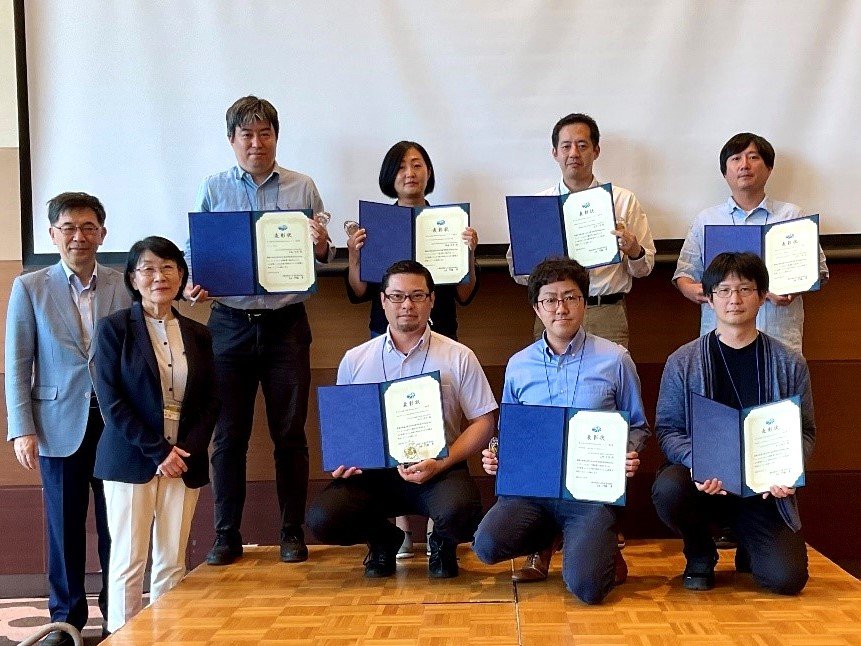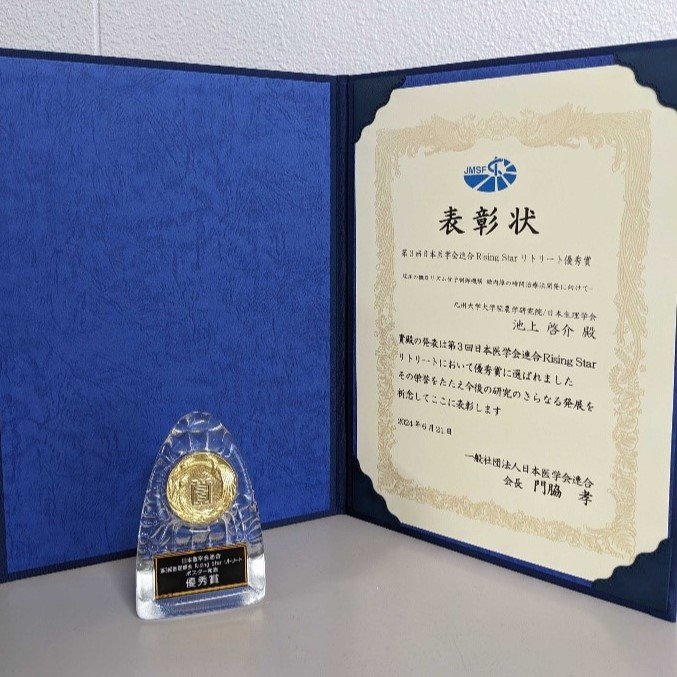[Topics] Associate Professor IKEGAMI Keisuke has received the Poster Award at the 3rd Japan Medical Association Union Rising Star Retreat

Associate Professor IKEGAMI Keisuke from Kyushu University's Faculty of Agriculture has received the Poster Award at the 3rd Japan Medical Association Union Rising Star Retreat. The awarded research achievement is titled "Molecular Mechanisms of Circadian Rhythm Control of Intraocular Pressure: Towards the Development of Chronotherapy for Glaucoma."
Japan Medical Association Federation Rising Star Retreat Poster Award
The Japan Medical Association Union is a nationwide academic organization representing Japanese medical societies. Its purpose is to "contribute to the standards of medicine and healthcare in Japan by promoting research in medical science and technology and upholding the code of conduct for medical researchers." Currently, it comprises 142 societies: 15 in the basic sciences, 20 in the social sciences, 61 in clinical internal medicine, and 46 in clinical surgery, with a total membership exceeding one million.
The Rising Star Retreat is primarily organized by the basic sciences division, with planning committee members from five rotating societies (this time, the Physiological Society of Japan, the Japanese Society of Pathology, the Japanese Society for Immunology, the Japanese Biochemical Society, and the Japanese Society for Virology). Fifty promising young and mid-career members, who have received encouragement awards from related societies, are recommended to participate. This gathering aims to revitalize basic medical science through research presentations and interdisciplinary exchanges.
The Poster Award is given to researchers who deliver outstanding presentations, demonstrating excellent presentation skills.
SUMMARY

It is said that 80% of human perception is obtained through vision. Intraocular pressure (IOP) plays a crucial role in the eye's function, similar to a camera, by helping to quickly focus and form clear images on the retina. The pressure inside the eye is maintained at a constant level to achieve this. However, when IOP becomes abnormal, it can damage the optic nerve and lead to a condition called glaucoma. Glaucoma is the leading cause of blindness, and once it develops, it can only be slowed down; there is currently no cure.
Intraocular pressure (IOP) exhibits a diurnal variation, rising at night regardless of whether the organism is diurnal like humans or nocturnal like mice. It has been found that disruptions in this rhythm or a reversal of day and night can increase the risk of glaucoma. However, the detailed mechanisms behind these fluctuations have remained unclear until now.
Our research has discovered that two substances, "noradrenaline" secreted by the sympathetic nervous system and "glucocorticoids" secreted by the adrenal glands, convey time information to the eyes. Additionally, we have identified that cells called "macrophages" within the eye are involved in the mechanism that regulates intraocular pressure at night.
Recently, research has been progressing on the use of eye drops to supply nutrients such as fatty acids to the eyes, aiming to prevent eye diseases like glaucoma and enhance treatment efficacy.
Benefit
Intraocular pressure refers to the pressure inside the eye. When intraocular pressure becomes abnormal, it can lead to a condition called glaucoma. Particularly, if the intraocular pressure is too high, it can damage the optic nerve, which is very dangerous. Additionally, many patients with high intraocular pressure tend to have higher pressure at night compared to during the day. However, it is difficult to detect the increase in intraocular pressure at night with tests conducted during the day. Therefore, it is important to properly manage nighttime intraocular pressure for the treatment and prevention of glaucoma.
Currently, it is not well understood how intraocular pressure changes from day to night between patients and healthy individuals. Therefore, it is difficult to detect abnormalities in intraocular pressure rhythms that cause glaucoma. However, this research is expected to enable the early detection of abnormalities in intraocular pressure rhythms and glaucoma.
Currently, eye drops can lower intraocular pressure, but a method to control the fluctuating intraocular pressure throughout the day has not yet been found. With the advancement of this research, new medications that regulate intraocular pressure rhythms may be developed. If this happens, it is expected to improve the treatment and prevention of glaucoma, prevent blindness, and significantly enhance the quality of life (QOL).
Comments from the Award Winner

Glaucoma is a disease that increases with age, and it is said that more than 5% of people over the age of 40 in Japan are affected. Furthermore, as the population ages, this number is expected to increase even more. Therefore, developing methods for the prevention and treatment of glaucoma is a very important issue. This requires a broad approach that transcends specialized fields. You might be surprised to hear about 'research on glaucoma in agricultural science,' but by combining different fields, we believe we can contribute to human health, especially eye health. Such cross-disciplinary research is called 'translational research,' which involves applying basic research to actual medical care and treatment. If you are interested, please contact us.
Research-related inquiries
IKEGAMI Keisuke ,Associate Professor
Laboratory of Regulation in Metabolism and Behavior
Japan Medical Association Federation (General Incorporated Foundation)












 Contact
Contact
 Access Map
Access Map

